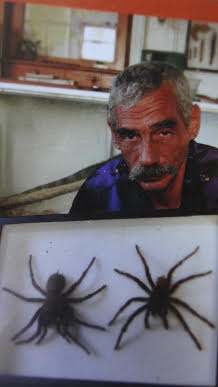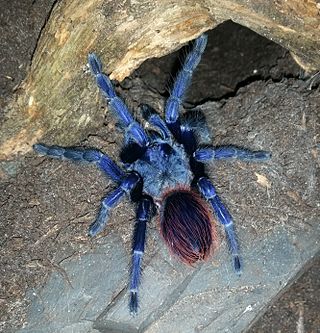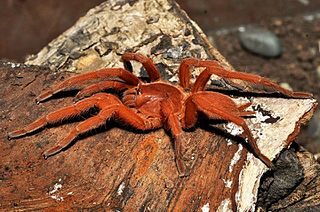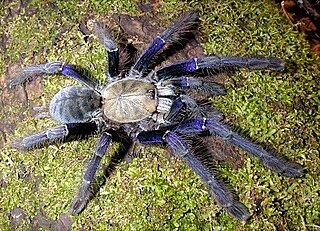
Theraphosa is a genus of South American tarantulas that was first described by Charles Athanase Walckenaer in 1805. The Theraphosa spiders are some of the largest known to science. As of May 2020 it contains three species, found in Guyana, Brazil, Venezuela, and Colombia. They stridulate by rubbing setae on their pedipalps and legs.

Aelurillus is a genus of spiders in the family Salticidae.

Theraphosa apophysis is a species of spider in the family Theraphosidae, found in Venezuela, Colombia and Brazil.

Lasiocyano is a genus of tarantulas. As of June 2023, it was a monotypic genus with the sole species Lasiocyano sazimai, synonym Pterinopelma sazimai, known as the Brazilian blue, iridescent blue or Sazima's tarantula. The species was first described by Rogério Bertani, Roberto Hiroaki Nagahama and Caroline Sayuri Fukushima in 2011. In 2012, it became the first Brazilian species to appear on the International Institute for Species Exploration's top 10 new species list.
The Ischnocolinae are a problematic subfamily of tarantulas. In 1892, Eugène Simon based the group, which he noted was only weakly homogeneous, on the presence of divided tarsal scopulae. This feature was later considered to be plesiomorphic, and both morphological and molecular phylogenetic studies have shown that, as traditionally circumscribed, the subfamily is not monophyletic. A much more narrowly defined Ischnocolinae sensu stricto was proposed in 2014. One of the authors of that proposal subsequently said that no further taxonomic changes should be considered until there had been a more comprehensive sampling of the subfamily. As of January 2021, the status of the Ischnocolinae remains unresolved.

Orphnaecus is a genus of tarantulas that was first described by Eugène Louis Simon in 1892. They have close to fifty lanceolate stridulatory spines on the chelicerae, known as "strikers". The male embolus has a single strong retrolateral keel. It is considered a senior synonym of Chilocosmia and Selenobrachys.

Chaetopelma is a genus of tarantulas that was first described by Anton Ausserer in 1871. They are found in Africa, Europe, and Asia including the countries of Turkey, Syria, Egypt, Cyprus, Greece, Sudan, Cameroon, and Iran.

Ischnocolus valentinus is a small, Old World tarantula. It is found in Spain, Sicily, Morocco, Algeria, Tunisia, Libya, and Western Sahara. It is the only species of true tarantula to occur in continental Europe, and one of two to occur in Europe along with Chaetopelma lymberakisi. It is the type species of the genus Ischnocolus. It is found in Mediterranean scrub with oaks and bushes, hiding under large flattish stones.

Lampropelma is a genus of Indonesian tarantulas that was first described by Eugène Louis Simon in 1892. As of March 2020 it contains two species, found in Indonesia.
Psednocnemis is a genus of Southeast Asian tarantulas that was first described by R. C. West, S. C. Nunn & Henry Roughton Hogg in 2012.
Aituaria is a genus of spiders in the family Nesticidae. It was first described in 1998 by Esyunin & Efimik. As of 2016, it contains two species, Aituaria nataliae and Aituaria pontica, the latter of which was transferred from Nesticus first to Carpathonesticus, then to Aituaria.
Leptopilos is a genus of ground spiders that was first described by G. Levy in 2009.

Omothymus is a genus of spiders in the family Theraphosidae, found in Malaysia, Indonesia and Singapore.

Neoholothele is a genus of tarantula, first described in 2015 by Guadanucci & Weinmann. As of August 2022, it contains 2 species Neoholothele fasciaaurinigra and Neoholothele incei, the latter being the type species. They are named after the prefix "neo" from the Greek word for new, and the genus Holothele.
Barbara Baehr is a German research scientist, entomologist, arachnologist, and spider taxonomist. She has described over 400 new spider species, mostly from Australia. She is originally from Pforzheim, Germany.

The Selenocosmiinae are a subfamily of tarantulas found throughout South-East Asia and Australia. This subfamily is defined by the presence of a lyra on the maxillae and strikers on the chelicerae, allowing these spiders to stridulate and produce a "hissing" sound. However some species within Phlogiellus may have secondary lost their lyra but retain their strikers. The monophyly of the subfamily has been only tested using genetic data with a handful of genera or species in a few studies. However, these studies found genera that had been previously placed in this subfamily were actual their own separate subfamily (Poecilotheria) and that Selenocosmiinae is most closely related to the Indian Thrigmopoeinae. As of 2021, Selenocosmiinae contains 11 genera.
Maratus combustus is a species of peacock spider native to Australia. The species was discovered together with Maratus felinus and Maratus aquilus by a research group from Monash University, near Lake Jasper in the South West region of Western Australia. However, the ranges of each species do not overlap.
Missulena faulderi is a species of mygalomorph spiders in the family Actinopodidae. It is found in Western Australia.

Venator marginatus is a wolf spider, endemic to Australia and found in Victoria.

Indopadilla insularis is a species of jumping spider from India.













